
| WWT Shows | CLICK TO: Join and Support Internet Horology Club 185™ | IHC185™ Forums |

|
• Check Out Our... • • TWO Book Offer! • |
Welcome Aboard IHC185™  Internet Horology Club 185
Internet Horology Club 185  IHC185™ Discussion Site Main Page
IHC185™ Discussion Site Main Page  Our Exclusive "Timekeepers Photo Gallery"
Our Exclusive "Timekeepers Photo Gallery"  IHC185™ "Timekeepers Photo Gallery"
IHC185™ "Timekeepers Photo Gallery"  CANADIAN Private-Label Watches
CANADIAN Private-Label Watches
 Internet Horology Club 185
Internet Horology Club 185  IHC185™ Discussion Site Main Page
IHC185™ Discussion Site Main Page  Our Exclusive "Timekeepers Photo Gallery"
Our Exclusive "Timekeepers Photo Gallery"  IHC185™ "Timekeepers Photo Gallery"
IHC185™ "Timekeepers Photo Gallery"  CANADIAN Private-Label Watches
CANADIAN Private-Label WatchesRelated Content: Larry Buchan's ..."Tales from the Rails"
Go  | New Topic  | Find-Or-Search  | Notify  | Tools  | Reply to Post  |  |
| Railway Historian IHC Life Member Site Moderator |
CPR station Ingersoll 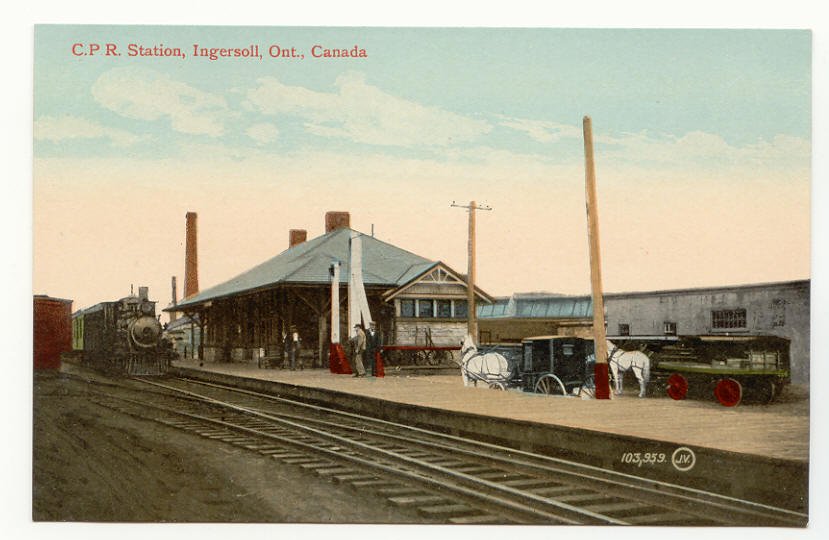 | |||
| Railway Historian IHC Life Member Site Moderator |
CNR Station Ingersoll, Ontario on ex GTR (Grand Trunk Railway)  | |||
| IHC Member 1357 |
Larry,that is one more nice dial.First one I have seen like that.Thanks for sharing. Regards Roger | |||
| Railway Historian IHC Life Member Site Moderator |
This Elgin 18 size, 7 jewel, open face, keywind and keyset, gilt movement, Grade 12, Serial No.325234, Manufactured 1874, must be my earliest Canadian Private-label. It is marked C.P. Hall on the single sunk Roman numeral dial, and C.P. Ingersoll, Ont., on the movement that has a heart-shaped cutout in the balance cock, the movement is missing the cup that screws down on the barrel bridge around the winding arbor. It is cased in a Fahys coin silver case with a latch springed rear, and an inner back that hinges over to the side. 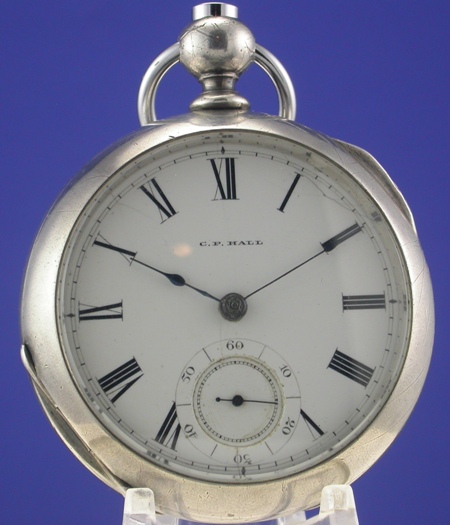 | |||
| Railway Historian IHC Life Member Site Moderator |
Dial  | |||
| Railway Historian IHC Life Member Site Moderator |
Movement. Oxford Tribune and Dairy Reporter July 11, 1877. Mercantile; CP Hall who is now the oldest merchant of Ingersoll. Mr. Hall is a native of this immediate vicinity, and for 48 years has been a resident of the town, though, if we are not misinformed, his boyhood and youth were passed in farming. In 1848, Mr. Hall made his first venture upon the troublous mercantile sea. He was not overburdened with capital, but had managed to accumulate between a hundred and fifty, and two hundred dollars, and with this as capital he opened a modest grocery store on King Street. Continuing the grocery trade 2 or 3 years he then made a radical change in his business, becoming the jeweler. About this time the Great Western Railway was being built money was plenty, and the luxuries of life were in about the same demand that the necessities are now. The business provided a success, and Mr. Hall has remained identified with the jewelry industry ever since. There are a few older established dealers in the Province and as the changing years have cultivated in the tastes of people, we find his establishment now of a character that will reflect credit upon replaced twice the size of this. It has not been all plain sailing with Mr. Hall. - every venture has not proved equally prosperous. At an early day in the history of the town he became largely interested in real estate, and in the disastrous fires that have prevailed from time to time, he has been a heavy loser. Then, too, it is a matter of fact that he has paid many a thousand dollars of other people's indebtedness, simply by having loaned his name as mere matter of form and these unlucky hits have doubtless conspired to keep him in business. Be that as it may, he is now as for years past, he has been one of the leading businessman of the town. In addition to his elegant place of business here, Mr. Hall has another jewelry house at Exeter, and not until recently, also had one Woodstock, Ontario. His place. Here is one of the institutions of the town, and makes a handsome display of everything appertaining to the jewelry trade as also musical merchandise and fancy goods. A large watch and other repairing business is done. Thus far this year trade shows an improvement over last, and we have called this remained a fact to be chronicled from year-to-year, as long as he remains one of the business fraternity of Ingersoll, Ontario. 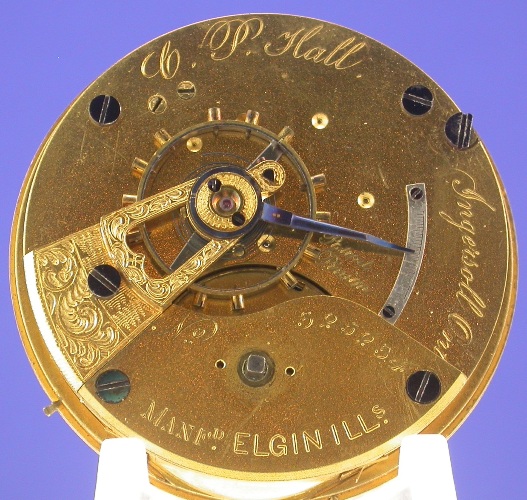 | |||
| Railway Historian IHC Life Member Site Moderator |
Fayhs 18 size coin silver case  | |||
| Railway Historian IHC Life Member Site Moderator |
Coin silver case back  | |||
| Railway Historian IHC Life Member Site Moderator |
Great Western Railway was a historic Canadian railway that operated in Canada West and later the province of Ontario following the countries Confederation in 1867. The system stretched 852 miles running from Niagara Falls to Toronto and connecting lines to London, Windsor, and communities in the Bruce Peninsula linking the Niagara and Detroit rivers with railroads of the USA. Having begun operations in 1853, with mixed gauge "Provincial" 5 feet 6 inches between Niagara Falls and Toronto the company was purchased in August 1882 by the Grand Trunk Railway system and fully merged by 1884. The main Niagara Falls-Windsor line is now the Canadian National Railway's Grimsby Subdivision, Dundas Subdivision, Chatham Subdivision and CASO (Canadian Southern) Subdivision. The Toronto branch is the Oakville Subdivision, and this Sarnia branch is the Strathroy Subdivision. Its headquarters was in Hamilton, Ontario. At Niagara Falls on the American side the Great Western Railway connected with what was later became the Rochester and Niagara Falls branch of the New York Central  | |||
| Railway Historian IHC Life Member Site Moderator |
Eastern Railway lines map showing blue CNR lines (ex. GTR, GWR lines.) From Niagara Falls to Ingersoll, going northwestward through Hamilton, Bradford, and Woodstock, Ontario. The New York Central lines are in green, and, from Buffalo, New York and continue southeastward through St. Thomas, Ontario, and into Michigan.  | |||
| Railway Historian IHC Life Member Site Moderator |
Friend and mentor of mine, Richard J. Cook wrote many books on railroad history and in 1987 wrote a book "The Beauty of Railroad Bridges" his fascination with these structures came naturally, as a boy living near the New York Central mainline at Cleveland, Ohio, after working nine years as a commercial photographer, he left the studio to follow his first love: railroading. As an operator-leverman for the New York Central in the post-World War II days, the author/photographer spent a year signaling the Central's "Great Steel Fleet" across the Cayahoga River drawbridge on Cleveland's lakefront. A graduate of Ohio Hiram College with a degree in English, he continued with his writing and photography, the last 16 years of which were with the Brotherhood of Locomotive Engineers, from which he retired in 1985, as director of publications and chief photographer. He was a life long rail enthusiasts and photographer, contributing illustrated articles to many railroad publication, and published many books, including Rails Across the Midlands 1968, Famous Steam Locomotives 1975, Super Power Steam Locomotives, 1980. The 20th Century Limited 1938-1967, 1993, New York Central's Mercury the Train of Tomorrow, 1996. I have the opportunity to meet Richard at the Brotherhood of Locomotive Engineers Convention in Cleveland in 1991, after he had retired, we started corresponding and I bought several of this publications, I have the opportunity to visit with him and another retired Brotherhood of Locomotive Engineers officer in 1993, we spent a pleasant afternoon driving from Cleveland to Canton, Brewster, Dover, and Sugar Creek Ohio, visiting railroad museums and other rail related attractions.  | |||
| Railway Historian IHC Life Member Site Moderator |
Niagara Falls Suspension Bridge John Augustus Roebling mechanical engineer and suspension bridge builder born in Germany 1806 came to America in 1831 with his brother Carl an interesting time, while initially he and his brother were interested in agriculture buying a 1600 acre farm near Butler, Pennsylvania, after his brother died in 1837 he returned to engineering for which he was trained for in Germany. At the time many transportation projects were underway near the location of his farm, he initially spent three years improving river navigation, canal building, and surveying railway lines across the Allegheny Mountains from Harrisburg to Pittsburgh, in 1840 he assisted suspension bridge designer Charles Ellet, Jr. with the design of a bridge near Philadelphia. At that time canal boats from Philadelphia were transported over the Allegheny Mountains on railroad cars to access waterways on the other side of the mountains so the boats could continue on to Pittsburgh. The system of inclines and levels that move the boats and conventional railroad cars was a state owned enterprise, the Allegheny Portage Railroad. The railroad cars were pulled up and down the inclines by a long loop of thick hemp rope, up to 3 inches thick, these ropes were expensive and had to be renewed frequently. Roebling had read about wire ropes, and soon after developed a seven strand wire rope at a ropewalk that he built on his farm. In 1844. Roebling won a contract to replace a wooden canal aqueduct across the Allegheny River with a wooden structure supported by many of his wire ropes, this was followed in 1845, by building a suspension bridge over the Monongahela River at Pittsburgh, in 1848. He undertook the construction of four suspension aqueducts on the Delaware and Hudson Canal, during this period he moved his wire rope production to a large, complex in Trenton, New Jersey, Roebling specs project, starting in 1851, was a railroad bridge connecting the New York Central Railway and Great Western Railway of Canada over the Niagara River, this project took four years. The bridge, with a clear span of the 225 feet, was supported by for 10 inch wire cables, and had two levels, one for vehicles and the other for rail traffic. Roebling went on to build many other suspension bridges including The Roebling Suspension Bridge over the Ohio River between Covington, Kentucky and Cincinnati, Ohio in 1867, which was the world's longest suspension bridge at the time it was finished, in 1867. Roebling went on to start design work on to what was to be his most famous work, the Brooklyn Bridge spanning the East River in New York between Manhattan and Brooklyn, unfortunately due to an injury in 1868. He never finished the job, but his son Washington A. Roebling and his wife went on to complete the structure that opened for use on May 24, 1883.  | |||
| Railway Historian IHC Life Member Site Moderator |
This beautiful line drawing of Roebling's Niagara River Suspension Bridge from a French publication, this drawing illustrates a cross-section of the structure showing the rails on the top deck and the highway underneath. Note all the extra bracing cables tied to the bank, thus giving the bridge the required stiffness for train travel  | |||
| Railway Historian IHC Life Member Site Moderator |
Huge pin connected braces anchor the supporting cables into rock to a depth of 25 feet on both sides of Niagara Gorge.  | |||
| Railway Historian IHC Life Member Site Moderator |
A single track runs through the upper deck of the bridge, supported by great towers of stone and miles of wire rope cable.  | |||
| Railway Historian IHC Life Member Site Moderator |
This side view of the bridge itself, gives a good idea as to all the bracing required to keep the bridge rigid. The railroad was on the top deck, and the pedestrians and wagons were restricted to the lower deck. 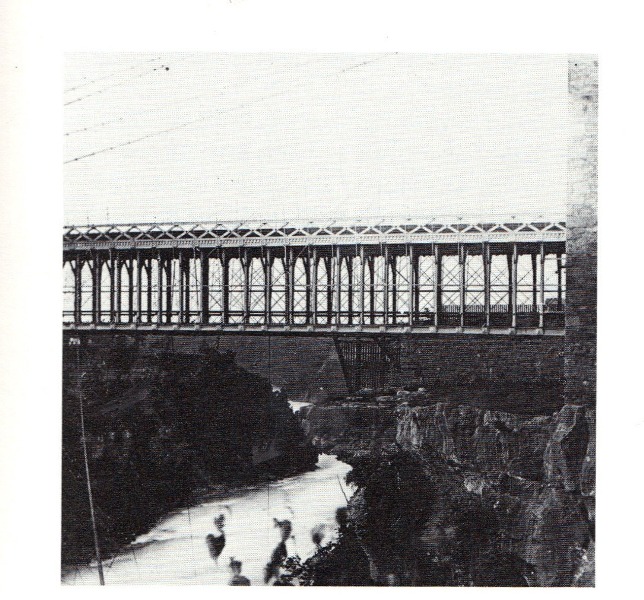 | |||
| Railway Historian IHC Life Member Site Moderator |
The summertime view looks out on the Roebling suspension bridge and Niagara Falls, Ontario on the Canadian side of the bridge. From this angle, the viewer can get a good idea of just how magnificent this bridge was, and of its size.  | |||
| Railway Historian IHC Life Member Site Moderator |
By train over the Niagara Gorge! The Roebling suspension bridge quickly became a tourist attraction and photographs or illustrations of the famous structure were used in many a travel brochure and advertising broadside. Now I passenger could travel between New York and Chicago over two routes and with the option of stopping off at Niagara Falls.  | |||
| Railway Historian IHC Life Member Site Moderator |
Shortly after the bridge was opened to rail traffic, the track across the structure was gauntleted in order to cut down on switching at both ends. A double track on each end formed formed a single track across the bridge. Note the stub switch in the foreground on the American side of the bridge.  | |||
| Railway Historian IHC Life Member Site Moderator |
The book The American Railway Published in 1888, Included these two line drawings of the towers of Roebling's suspension bridge. (LEFT) the original stone tower. At the right, the new iron towers. The iron towers were built in front of the stone towers, hence traffic over the bridge was not interrupted during the work. The suspension bridge remained until 1897 when a larger, heavier steel structure replaced it. 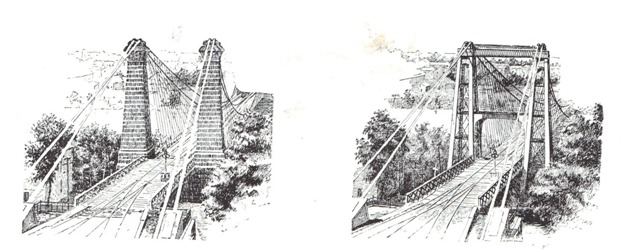 | |||
| Railway Historian IHC Life Member Site Moderator |
Brotherhood of Locomotive Engineers charter with Roebling's Niagara River Suspension Bridge. Engraving | |||
| Powered by Social Strata | Page 1 ... 32 33 34 35 36 37 38 ... 52 |
| Your request is being processed... |
|
©2002-2025 Internet Horology Club 185™ - Lindell V. Riddle President - All Rights Reserved Worldwide


